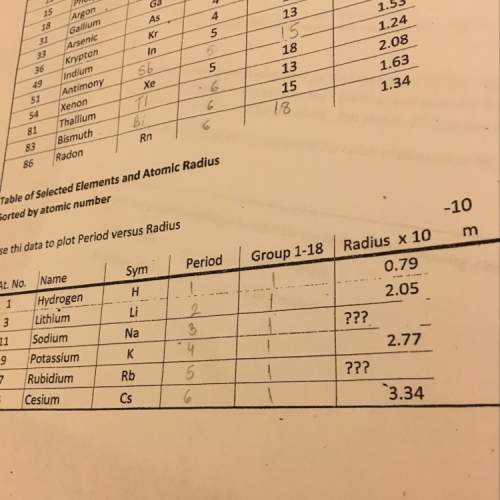
Chemistry, 16.12.2021 18:10 kimjooin02
A sample of 10.5 g of nitrogen reacts with 20.2 g of hydrogen to produce ammonia. 3H^2 (g) + N^2 (g) = 2NH^3 (g)


Answers: 2


Another question on Chemistry

Chemistry, 22.06.2019 12:10
|using the periodic tablewarm-upuse the periodic table in the tools bar to answer the following questions.what elemental classification does oxygen belongto? done
Answers: 3

Chemistry, 22.06.2019 14:30
Ahypothesis must be testable and falsifiable to be considered scientific a. trueb. false
Answers: 1

Chemistry, 22.06.2019 15:30
Draw the lewis dot structure for each of the following polyatomic ions
Answers: 1

Chemistry, 22.06.2019 17:50
Cryolite, na3alf6(s), an ore used in the production of aluminum, can be synthesized using aluminum oxide. start this question by first balance the chemical equation.1.) balance the equation: - alo3(s)+naoh(l)+hf(> na3alf6+h2o(g). 2.) if 17.5 kilograms of al2o3(s), 51.4 kilograms of naoh(l), and 51.4 kilograms of hf(g) react completely, how many kilograms of cryolite will be produced? 3.)which reactants will be in excess, (al2o3, naoh, or hf) 4.)what is the total mass of the excess reactants left over after the reaction is complete in kg?
Answers: 2
You know the right answer?
A sample of 10.5 g of nitrogen reacts with 20.2 g of hydrogen to produce ammonia.
3H^2 (g) + N^2 (...
Questions

Mathematics, 02.05.2021 20:30

Biology, 02.05.2021 20:30





Chemistry, 02.05.2021 20:30

Mathematics, 02.05.2021 20:30

Mathematics, 02.05.2021 20:30



Mathematics, 02.05.2021 20:30

French, 02.05.2021 20:40



Mathematics, 02.05.2021 20:40


Biology, 02.05.2021 20:40


Biology, 02.05.2021 20:40




